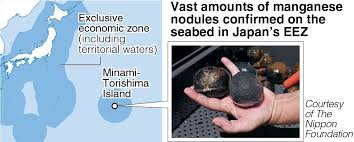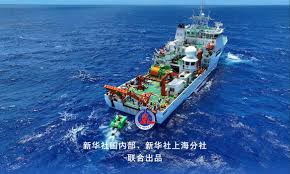
中國:錳結核開採將於2025年啟動
距離南鳥島海岸 600 公里的國際水域發生 BPHD。
中國五礦在夏威夷近海國際海域
我們將為您提供讀賣新聞上發表的文章摘要。

China’s rare metal mining plan:
China will mine manganese nodules in two locations in the international waters of the Pacific Ocean in the summer of 2025.
Large-scale testing has revealed plans to mine up to 7,500 tons.
1. International waters off the coast of the Ogasawara Islands and Minamitorishima (Tokyo) in the North Pacific
2. International waters off the coast of the Hawaiian Islands in the South Pacific.
Near-commercial-scale mining will be carried out on the deep seabed at a depth of 5,000 meters.

Near-commercial-scale mining will be carried out on the deep seabed at a depth of 5,000 meters.
International Seabed Authority (ISA) rules:
1. Under the United Nations Convention on the Law of the Sea, seabed minerals on the high seas are the common property of mankind.
2. It is managed by the International Seabed Authority (ISA, headquartered in Jamaica).
Currently, the ISA has no international regulations. Countries cannot commercially develop in the high seas.
China holds exclusive exploration rights:
However, the ISA has granted exclusive exploration rights to China, a country that possesses certain technology.
1. China can monopolize and explore specific sea areas as a preparatory stage for development.
2. China has already obtained exclusive exploration rights off the coast of Minamitorishima, which is close to Japan’s EEZ.

Next August, China will mine in the exclusive exploration area off Minamitorishima for 20 days.
1. The mining equipment will suck up manganese nodules from the seabed like a vacuum cleaner.
2. A special device will be used from the mother ship to suck up manganese nodules from 250,000 km2 of the seabed.
3. This time, the minerals will not be salvaged, but up to 7,500 tons will be collected from the seabed.
BPHD will investigate the impact of seabed mining on the ecosystem.

China Minmetals: Off the coast of Hawaii, high seas of CCZ
China Minmetals, a Chinese state-owned company, has also filed a plan for off the coast of Hawaii.
1. Mining will take place in the high seas off the coast of Hawaii from July to October next year.
2. 1,300 tons of manganese nodules will be collected from the seabed and several tons will be salvaged.

ISA to discuss international rules:
The ISA General Assembly next summer aims to “establish international rules for the trade of seabed minerals.”
If commercial trading is allowed, China will gain an advantage by moving into large-scale mining.

Development of seabed resources within the EEZ:
Japan has already acquired development rights for the development of seabed resources within the EEZ.
Tokyo University: Professor Yasuhiro Kato (Earth Resources)
1. If China is successful in its mining tests, China’s mining technology will become the best in the world.
2. Japan should take advantage of its advantage of having resources within its EEZ and accelerate development.
https://www.yomiuri.co.jp/science/20241130-OYT1T50178/3/

China’s push into deep-sea mining gathers speed
・taking big steps towards mining the deep seabed,
・but critical gaps in understanding environmental impacts remain
Summary from Dialogue Earth Report.

Pioneer II:
a deep-sea mining vehicle developed by Shanghai Jiao Tong University, photographed in June 2024.
The vehicle completed a mining trial at a depth exceeding 4km, a national record.
Experts have told Dialogue Earth :
1.Chinese companies may not wish to mine imminently
2.but are positioning themselves at the head of the race to do so.

Trial deep-sea mining equipment:
Two Chinese enterprises are preparing to trial deep-sea mining equipment in the Pacific Ocean next year.
1.China’s first step to the commercialisation of deep-sea mining.
2.Expand its deep-sea mining development over the last decades.
China Minmetals and BPHD:
1.preparing to conduct trials of mining vehicles in their Pacific exploration zones next year.
2.They Announced in April and May this year respectively.
Duncan Currie says : a legal adviser to the Deep-Sea Conservation Coalition
1.the effect mining will have on deep-sea ecosystems that remain understudied.
2.There isn’t enough scientific information to be able to assess the effects of a test, let alone full mining.

Driving a 20-tonne truck, 5km down:
China Minmetals developed a collector vehicle of 9 metres long, 5m wide and weighing 40 tonnes.
1.a vehicle would be deployed several ㎞ below the surface.
2.scrape the seafloor to collect mineral-packed nodules.
The trial the company is planning to launch next year will mainly involve this vehicle.

A massive drill ship towering :
The Hidden Gem, a deep-sea mining vessel pictured in 2023.
carrying a cargo of potentially 3,000 tons of deep-sea nodules .
1.This discharge, with the disturbance of the seabed during collection.
2.Pollution by the vehicle, are the impacts scientists are to study.

Chinese mining mechanism:
They recovered 1.2 tonnes of nodules from the 1.3km-deep seabed of the South China Sea.
Shanghai Jiao Tong University:
in June, tested a mining vehicle in the western Pacific Ocean at a national record depth of 4km.
They collected polymetallic nodules in 5 test dives, a Xinhua says.

Canada-based “The Metals Company”:
It recovered 3,000 tonnes of nodules from the seafloor in 2022.
The Metals Company is sponsored by the small island state of Nauru.
1. the first to take that step, and will apply for a licence from ISA.
2.this year to begin commercial mining in late 2025.

China’s growing influence:
China sent a large delegation of 12 people to the ISA meetings this year.
over 30 countries, including Guatemala, Honduras, Tuvalu, France, Canada and the UK, have called for a pause or outright ban on this kind of mining.